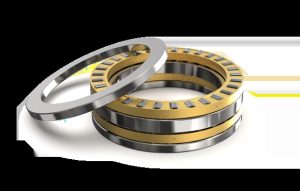Introduction to Thrust Bearings
Thrust bearings specialize in managing axial loads in various machinery. Unlike radial bearings, which handle loads perpendicular to the shaft, thrust bearings focus on loads parallel to the shaft. This makes them crucial in applications where axial loads are predominant, such as in automotive and aerospace industries.
Characteristics of Thrust Bearings
Load Handling
Thrust bearings excel in bearing axial loads. They come in various designs, such as ball thrust bearings and tapered roller thrust bearings, each tailored for specific load capacities and operational conditions.
Design and Material
Manufacturers often use high-grade steel or other alloys for thrust bearings to ensure durability and resistance to wear and tear. The design typically involves a series of rollers or balls between two washers, providing a smooth rotational surface.
Efficiency and Speed
These bearings offer high efficiency in managing axial forces, contributing to the overall speed and performance of the machinery. Their design reduces friction, which directly impacts the speed at which a system operates.
Comparison with Other Types of Bearings
Radial Bearings
Radial bearings differ significantly as they are designed to handle loads perpendicular to the axis of rotation. They are not ideal for applications where axial loads are significant.
Angular Contact Bearings
Angular contact bearings can handle both axial and radial loads. However, they are less efficient in managing pure axial loads compared to thrust bearings.
Roller Bearings
Roller bearings are similar to ball bearings but use cylindrical rollers instead of balls. They are more effective in carrying heavier radial loads but not exclusively designed for axial loads like thrust bearings.
Application-Specific Advantages
Automotive Industry
In vehicles, thrust bearings support axial loads in transmissions and provide smooth gear shifting.
Aerospace Industry
They are essential in aircraft, handling axial loads in jet engines and ensuring efficient operation at high speeds.
Key Specifications and Parameters
Load Capacity
Thrust bearings are rated for specific axial load capacities. Exceeding these limits can lead to premature failure.
Dimensions and Size
The size of the bearing directly relates to its load capacity and suitability for specific applications.
Lifespan and Durability
The lifespan of a thrust bearing depends on its material quality, maintenance, and operational conditions. Regular maintenance can significantly extend its life.
Cost and Budget Considerations
The cost of thrust bearings varies depending on size, material, and specific design features. Budgeting for high-quality bearings can save costs in the long run due to reduced maintenance and replacement needs.
Conclusion
Thrust bearings are indispensable in many industries due to their ability to efficiently manage axial loads. Understanding their design, functionality, and application-specific advantages is crucial for selecting the right bearing for any application. Investing in high-quality thrust bearings not only ensures operational efficiency but also contributes to the longevity and reliability of the machinery.
For more detailed information on thrust bearings, visit this link.
